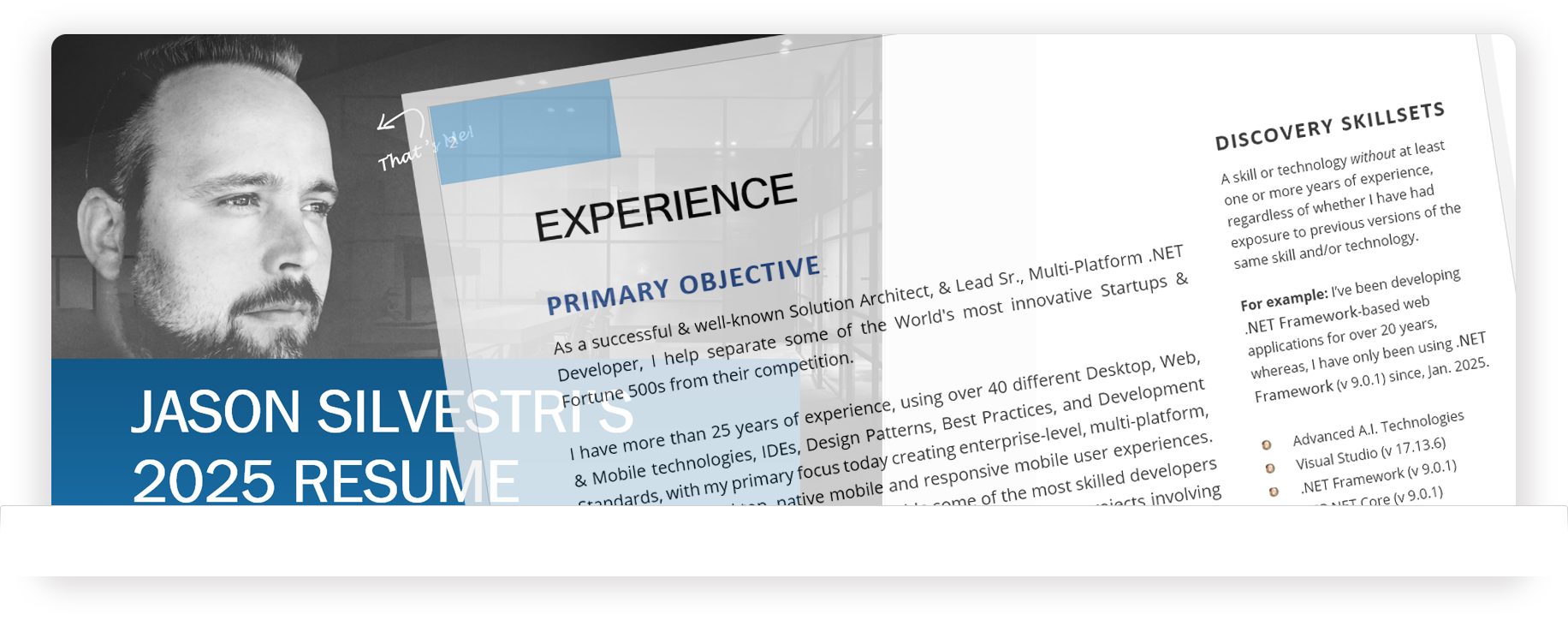I Do What I Do Because Even at Our Best, the Guy Next to Me Could Still Wipe Out a Special Forces Team with a Popsicle Stick

Based On Actual Events: I do what I do because even at our best, the guy next to me-even with-the-best-intentions-could still wipe out a special forces team with a popsicle stick. This is the story of how a lunchtime laugh turned into my lifelong mission to fight for standards that don’t buckle, no matter who’s holding the stick.
Hey, friends! Grab a seat—this one’s a doozy. It’s not your average “how I got into tech” yarn. This is about my messy start in development back in 2000, why I’m borderline obsessive about enterprise-level standards, and the lunch that turned my world upside down. It’s a wild ride, so let’s get to it.
Print, Comment, Like & Share this Article!
Easily generate, print, comment, like and/or share this page via one or more of your favorite social networks, using the share ribbon below! Simply click, comment, like and/or share automatically configured posts of this article (or modify the post with your own custom commentary)!
Table of Contents
- The Dawn of a Career: A Teenager in Over His Head
- The Wild West of Early 2000s Tech: Paper, Chaos, and Million-Dollar Bets
- Lunchtime Laughs in a Pressure Cooker
- The Popsicle Stick That Dropped Like a Bomb
- Two Decades of Nightmares and a New Purpose
- JSopX™: Building a Shield Against Chaos
- The Story’s Not Over Yet
- In Closing
The Dawn of a Career: A Teenager in Over His Head
Summer 2000. I’m 18, fresh from high school, when my dad—a sharp, driven guy who always had a plan—sits me down at dinner. The kitchen’s warm, plates clattering as he says, “Jason, I’ve lined up a gig for you in Product Data Management.” PDM? Sounded like alphabet soup to me. But he had that look—half challenge, half promise—and before I knew it, I was stepping into a world I couldn’t have dreamed up on my own.
This wasn’t a summer job flipping burgers. I was tossed into the deep end with Fortune 500 heavyweights—sprawling campuses, endless hallways of buzzing cubicles, and boardrooms thick with the scent of coffee and big ideas. PDM was the scrappy little brother of what we’d later call Product Lifecycle Management (PLM), and I was there at the start, a kid surrounded by engineers and suits throwing around terms I scrambled to jot down. Over the next five years, I got a crash course in complex business models, multi-year projects, and software so tough it felt forged in a furnace. I had no idea how high the stakes could climb.
The Wild West of Early 2000s Tech: Paper, Chaos, and Million-Dollar Bets
Picture early 2000s tech—still shaking off the Y2K jitters. “Workflows” and “life cycles” were half-baked buzzwords, not features. Most processes lived on paper—faded blueprints and scribbled notes passed hand-to-hand like contraband. Digital flowcharts? A pipe dream. If you wanted a system to track a product from start to finish, you’d drop millions on clunkers like MatrixOne or PTC’s Windchill—hulking platforms that came out of the box rigid and needed a small army of PLM consultants to bend into shape.
Those consultants were a breed apart—think weathered pros in faded polos, hauling briefcases stuffed with assembly-line sketches, chain-smoking by loading docks while arguing over tolerances. Outsourcing wasn’t even a whisper yet—everything was local, high-stakes, and often locked behind security clearances that made you feel like you’d stumbled into a spy flick. Jobs were gold dust: rare, well-paid, and brutal. I was a nobody, wide-eyed and out of my depth, but I was there, watching giants build software where a single slip could tank everything. Precision wasn’t optional—it was life or death.
Lunchtime Laughs in a Pressure Cooker
Pause for a sec and think about today: a bad actor slips a few rogue digits or characters into an email field—boom, your app’s toast. Basic input validation or database constraints? Skip those, and it’s lights out. Worse, a crafty jerk with some sloppy JavaScript or a retro DOS attack can tank it on purpose, brute-forcing their way in. But here’s the kicker: even with every i dotted and t crossed, a good soul—someone who cares—can still fat-finger one field and unravel it all. Now scale that up. Picture a tactical helicopter—millions of parts, thousands of inputs, a PLM beast sprawling across screens and workflows. Every piece has to be perfect, because one glitch among a million can send it screaming to the ground. Back then, we lived that pressure daily, wired to handle it. So, yeah—lunchtime.
He’d taken a rare week off—first break in ages after steering this beast of a project through the fire. No one flinched. His team was rock-solid—decades of experience, PhDs, the full package. Our PLM system was bulletproof: physics triple-checked, units locked down, every test glowing green. I’d watched that week unfold—smooth sailing at first, then a few engineers scratching their heads by Wednesday, one guy muttering to himself in the bathroom like he’d lost the plot. Nothing major, though. No sirens. The senior guy strolls back Monday, tanned and chipper, raving about beach time with his kids. All good, right?
Not even close. He’s chuckling now, the table leaning in. “Friday night, I’m flipping burgers, phone explodes—red alert. They’re losing it at the factory; rotor test’s off by a hair. I roll in Saturday, still in flip-flops, and crack it in 15 minutes.” He pauses, eyes glinting. “It was a popsicle stick.”
Cut back to the gig with Life Cycle Solutions. I’m on-site with a classified military defense contractor—barbed wire fences, ID badges checked twice, and helicopters so cutting-edge they’re still hush-hush. We’d been grinding for almost a year, crafting a PLM system for a chopper built from thousands of parts. The latest release was a home run—months of testing across teams, divisions, and workflows, all clicking like a Swiss watch. The air buzzed with triumph.
Lunch that day was a victory lap. We’re sprawled around a conference table, sandwich wrappers and soda cans piling up, the hum of fluorescent lights blending with easy chatter. My crew’s trading war stories with the client’s engineers—guys with calloused hands and degrees out the wazoo. The mood’s light, almost festive. We’d earned it. Then their senior engineer—a silver-haired vet who’d forgotten more about rotors than I’d ever know—leans back, wiping mustard off his lip with a napkin. “So,” he says, a grin tugging at his mouth, “you won’t believe what happened while I was on vacation.”
The Popsicle Stick That Dropped Like a Bomb
He’d taken a rare week off—first break in ages after steering this beast of a project through the fire. No one flinched. His team was rock-solid—decades of experience, PhDs, the full package. Our PLM system was bulletproof: physics triple-checked, units locked down, every test glowing green. I’d watched that week unfold—smooth sailing at first, then a few engineers scratching their heads by Wednesday, one guy muttering to himself in the bathroom like he’d lost the plot. Nothing major, though. No sirens. The senior guy strolls back Monday, tanned and chipper, raving about beach time with his kids. All good, right?
Not even close. He’s chuckling now, the table leaning in. “Friday night, I’m flipping burgers, phone explodes—red alert. They’re losing it at the factory; rotor test’s off by a hair. I roll in Saturday, still in flip-flops, and crack it in 15 minutes.” He pauses, eyes glinting. “It was a popsicle stick.”
I choke on my Coke. “A… what?”
“You know,” he says, gesturing with his hands, “the wooden stick from a freezer pop. They forgot to stick one—or something like it—on the rotor blade’s backside during testing. Without that tiny weight, the rotation’s off. Over time, vibrations could shred the whole thing. I’ve got a box of ‘em on the shelf by the station—told those knuckleheads, ‘Use it!’” He’s howling, slapping the table. “Little things, Jason. Gotta love ‘em.”
The room erupts. I force a laugh, but my stomach’s plummeting. A popsicle stick? We’d built a system for a war machine worth millions, checked every box, ran every scenario, and it could still fail over a snack scrap you’d chuck after a hot day. If that rotor quit mid-flight, a special forces team—real people with families and missions—could crash and burn. And it’d be on us. On me. I saw it in my head: the chopper spinning, the fireball, the silence after. All because of a stick.
Two Decades of Nightmares and a New Purpose
That lunch broke something in me. I was in my 20s, staring at a truth I couldn’t shake: we weren’t in control. Not me, not the team, not the system. We could have the best tools, the sharpest minds, endless budget, and still be one dumb miss away from catastrophe. It wasn’t a punchline—it was a nightmare. For years, I’d bolt awake, soaked in sweat, picturing that chopper spiraling, the rotor snapping, all because we didn’t see something so stupidly small.
I threw myself into the fight. Full-stack dev became my proving ground—web, mobile, desktop, anything I could master. I clashed with stakeholders over workflows, rode the waves of tech trends, and wore the “jack of all trades” tag like armor. Back then, selling teams on standards was like herding cats—basic life cycles were a win, forget enterprise discipline. But I kept swinging, driven by that popsicle stick. Today, tech’s a sprint—weeks do what took years—but the stakes haven’t budged. A typo can kill an app. A bad actor can gut you. A good one can screw up just as bad. Precision’s still the razor’s edge.
The Story’s Not Over Yet
This is just the opening act. That lunch lit a fuse, and there’s more to unpack—more close calls, more lessons, more reasons I’m still here swinging. I’ll loop back to flesh this out, but for now, I hope it lands with you. Double-check your work. Fight for what’s right. Build with care. Got thoughts? Hit me below or share this out—I’d love to hear. Stay tuned, friends. We’re just warming up.
In Closing
I’ll choose team collaboration, and what is best for the business, over self-preservation, any day. This choice doesn’t always make the best of friends, nor is it always the answer. Moreover, if you feel you or one or more team members are not team players, and/or are known for self-preservation, I will not be a good fit to work with you, in a contractor or full-time role capacity. However, I do respect all aspects of the argument.
 Choose from one of the following Resume Downloads in Word and/or PDF Format:
Choose from one of the following Resume Downloads in Word and/or PDF Format: